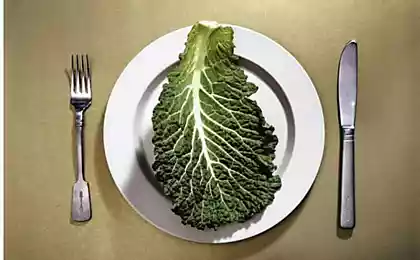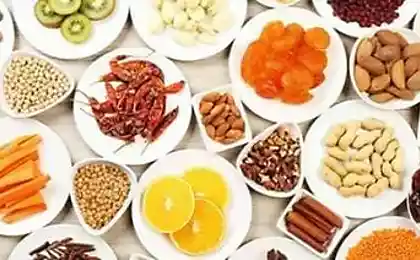653
What do the healthiest diets in the world
Health and weight, as is known from the mass of scientific research are inextricably linked. And, by the way, many scientists are inclined to conclude that the "extra" 5-7 pounds are not always superfluous, and moderately well-fed people can be much healthier than the dried reeds.However, the pursuit of the "ideal" weight and the quest for the "perfect" power is the inevitable trend of the last decades.

And even scientists are trying to derive a formula for the "ideal" power, based on the results of studies of the health of the inhabitants of certain regions of the world.And make sure that the Mediterranean diet, the French paradox, the Japanese diet, Nordic foods and many others can serve as an example of proper nutrition. But for all? Let's deal!
What is the difference between our usual diet and food in other countries? Our food is often unjustified consists of a large number of ingredients.
In fact, take a normal lunch in an average public catering of Russia or Ukraine:salad, first, second and compote. And every dish – a minimum of 3-4 components, often combined with each other!
In China lunch is a big bowl of soup, but from many components, but they are very harmoniously combined in the dish: vegetables, rice or rice noodles, broth, chicken or beef. In addition, we often volume eat more than others. But if we take into account the excess sugar, salt, all kinds of artificial additives in our dishes, the picture is joyless.
Yes, another fact: we are, unfortunately, not Thailand or Bali, where the year-round abundance of fresh vegetables and fruits, but because a few months a year, eat seasonal products, and imported, often exotic to us, or do not eat fresh fruits and vegetables.
In our diet a little seafood, fish, dairy products, but too much bread, products made with white refined flour and sugar, fat.
And now more about the most popular regional diets considered most healthy:
The Mediterranean diet
The traditional Mediterranean diet, included in the UNESCO list of humanity's achievements, it is a common food of the inhabitants of Greece, Italy, Spain. There is nothing "special", but the important thing for this type of food is seasonal, local foods and dishes and traditions. And the main tradition of family Lunches or dinners. In the diet of fruits, vegetables, whole grains, legumes, nuts and olive oil. Fish, poultry and red wine in moderation red meat, salt and sugar — in the "pen". The benefits of the Mediterranean diet began to be studied since the 70-ies of the last century, and the researchers found that "living" olive oil can help people lose weight, reduce the risk of cardiovascular disease and diabetes.And it is, indeed, very reasonable food.

New Nordic Diet New Nordic (Scandinavian) diet
On the basis of long-term studies of nutrition Scandinavian countries — Denmark, Finland, Iceland, Norway and Sweden, scientists have deduced the formula of the "ideal" power supply: 75 percent organic food, less meat, more whole grains and local produce. New Nordic Diet is very similar to the Mediterranean diet that places great emphasis on whole grains, fruits and vegetables, in addition, includes a sufficient number of eggs, oil and seafood, while meat, dairy products, desserts and alcohol — in very small amounts. Unlike the Mediterranean diet that the Northern diet uses canola oil instead of olive oil, and foods that are native to the Scandinavian countries:whole grains (oats and rye), local fruits and berries (rose hips, cranberries and blueberries), cruciferous and root vegetables (Brussels sprouts, broccoli, turnips, parsnips and beets); and low-fat dairy, dairy products and cheeses. Meat includes beef, pork, lamb and venison, are also widely used fish and shellfish: herring, mackerel and salmon. The desserts in the diet include cakes made with oat bran, or jam made from local berries. A lot of herbs and sauces: parsley, mustard, horseradish and onion.

A recent study published in the American journal of clinical nutrition found that a healthy diet, the Nordic diet has an effect on human genes, is responsible for the distribution of abdominal fat, and "off" genes associated with inflammation. Such a diet helped study participants lose weight at the same time providing a "high satisfaction", and reduce the risk of diabetes.
The traditional diet of Okinawa
I think many of you have heard about the phenomenon of the Okinawa region of Japan where one of the highest densities of long-livers, where an eighty-year old person is considered Mature and ninety starting to think about getting old. It is not only the number of years, but also in the quality of life: the Okinawan centenarians do not suffer from "diseases of old age", have no cholesterol deposits in the blood vessels, do not know what hypertension, heart attacks and strokes and are not affected by cancer.
The traditional diet of Okinawa is a low-calorie diet with lots of fruits and vegetables, and small — fish and seafood, meat, refined grains, sugar, salt and fatty dairy products. This diet was "born" in a very specific historical context: the island of Okinawa in Japan was one of the poorest regions in the country before the Second world war, and Confucian ideals, according to which, as they say we "eat to live, not live to eat", played a major role in shaping the food culture of the island, the basic principles which can be summarized as follows: frequent, small meals in multiple numbers, but low in calories, slowly and with pleasure.

The diet of Okinawans and vegetables, among which the main one is sweet potatoes — sweet potatoes, green leafy vegetables, soy products such as tofu and soy sauce. The Okinawans eat a modest amount of seafood, rice, lean meat, fruits and tea.
Alas, the modern inhabitants of the Okinawa caught up with their compatriots in material terms, "catching up" today, and mainland residents on the level of metabolic syndrome and cardiovascular diseases. But people who grew up on traditional food, and continue these traditions, still alive and adhere to their culinary customs. In fact, the island is home to one of the largest populations of centenarians in the world. These super-seniors to live an active life largely free from sickness and disability, and, as they say, very slow aging. Some researchers believe that the practice of long-term calorie restriction may play a big role in their durability.
Asian diet
There is not really one traditional Asian diet, it is difficult to compare, for example, the diet of the Middle and Far East. However, a group of international nutritionist collaborated in the 90-ies, I tried to make a "food pyramid" of Asia. At the base of this pyramid wasrice, noodles and whole grains, and fruits, vegetables, legumes, seeds and nuts. Next came fish and shellfish, as is the preference of daily choices, while poultry meat and eggs — only a couple of times a week. Please note that the recommended serving of red meat — less and less frequently (once a month) than even candy (weekly)!

Asian countries have less instances of obesity, cardiovascular disease and metabolic diseases such as type II diabetes than Western countries, although due to the economic growth and urbanization there is a further "blurring" of the difference.
The French paradox
Scientists have puzzled over the 'French paradox' or a dozen years. The French have one of the lowest obesity rates in the developed world and one of the highest life expectancies, despite the abundance and variety of the food they eat.Fatty cheeses, pates, yogurts, butter, bread, croissants, brioche and bread, chocolate and an abundance of sweets, wine, champagne, cognac — are among the highlights of this amazing diet.
If we so dreamy say food lovers! And remain the same slim centenarians, as a true French. What is the answer to this paradox? Some researchers believe that the main thing – not even a diet, but a way of life and eating the French:their portions are small, they do not eat anything on the go, they eat very slowly, enjoying every crumb, every bite, every SIP. But other scientists believe that the important role played by moderate consumption of red wine and the positive effects of cheese with mold.

In General, try it yourself: Yes with pleasure, with pleasure, in a good mood, varied and moderately, without Newspapers and TV news at the table with family and loved ones, a healthy, seasonal and local food — after all, these principles unite all the healthiest diet in the world! And be healthy and live long and happy! published
P. S. And remember, only by changing their consumption — together we change the world! ©
Source: www.abcslim.ru/articles/1585/chto-obcshego-u-samyh-zdorovyh-diet-v-mire/

And even scientists are trying to derive a formula for the "ideal" power, based on the results of studies of the health of the inhabitants of certain regions of the world.And make sure that the Mediterranean diet, the French paradox, the Japanese diet, Nordic foods and many others can serve as an example of proper nutrition. But for all? Let's deal!
What is the difference between our usual diet and food in other countries? Our food is often unjustified consists of a large number of ingredients.
In fact, take a normal lunch in an average public catering of Russia or Ukraine:salad, first, second and compote. And every dish – a minimum of 3-4 components, often combined with each other!
In China lunch is a big bowl of soup, but from many components, but they are very harmoniously combined in the dish: vegetables, rice or rice noodles, broth, chicken or beef. In addition, we often volume eat more than others. But if we take into account the excess sugar, salt, all kinds of artificial additives in our dishes, the picture is joyless.
Yes, another fact: we are, unfortunately, not Thailand or Bali, where the year-round abundance of fresh vegetables and fruits, but because a few months a year, eat seasonal products, and imported, often exotic to us, or do not eat fresh fruits and vegetables.
In our diet a little seafood, fish, dairy products, but too much bread, products made with white refined flour and sugar, fat.
And now more about the most popular regional diets considered most healthy:
The Mediterranean diet
The traditional Mediterranean diet, included in the UNESCO list of humanity's achievements, it is a common food of the inhabitants of Greece, Italy, Spain. There is nothing "special", but the important thing for this type of food is seasonal, local foods and dishes and traditions. And the main tradition of family Lunches or dinners. In the diet of fruits, vegetables, whole grains, legumes, nuts and olive oil. Fish, poultry and red wine in moderation red meat, salt and sugar — in the "pen". The benefits of the Mediterranean diet began to be studied since the 70-ies of the last century, and the researchers found that "living" olive oil can help people lose weight, reduce the risk of cardiovascular disease and diabetes.And it is, indeed, very reasonable food.

New Nordic Diet New Nordic (Scandinavian) diet
On the basis of long-term studies of nutrition Scandinavian countries — Denmark, Finland, Iceland, Norway and Sweden, scientists have deduced the formula of the "ideal" power supply: 75 percent organic food, less meat, more whole grains and local produce. New Nordic Diet is very similar to the Mediterranean diet that places great emphasis on whole grains, fruits and vegetables, in addition, includes a sufficient number of eggs, oil and seafood, while meat, dairy products, desserts and alcohol — in very small amounts. Unlike the Mediterranean diet that the Northern diet uses canola oil instead of olive oil, and foods that are native to the Scandinavian countries:whole grains (oats and rye), local fruits and berries (rose hips, cranberries and blueberries), cruciferous and root vegetables (Brussels sprouts, broccoli, turnips, parsnips and beets); and low-fat dairy, dairy products and cheeses. Meat includes beef, pork, lamb and venison, are also widely used fish and shellfish: herring, mackerel and salmon. The desserts in the diet include cakes made with oat bran, or jam made from local berries. A lot of herbs and sauces: parsley, mustard, horseradish and onion.

A recent study published in the American journal of clinical nutrition found that a healthy diet, the Nordic diet has an effect on human genes, is responsible for the distribution of abdominal fat, and "off" genes associated with inflammation. Such a diet helped study participants lose weight at the same time providing a "high satisfaction", and reduce the risk of diabetes.
The traditional diet of Okinawa
I think many of you have heard about the phenomenon of the Okinawa region of Japan where one of the highest densities of long-livers, where an eighty-year old person is considered Mature and ninety starting to think about getting old. It is not only the number of years, but also in the quality of life: the Okinawan centenarians do not suffer from "diseases of old age", have no cholesterol deposits in the blood vessels, do not know what hypertension, heart attacks and strokes and are not affected by cancer.
The traditional diet of Okinawa is a low-calorie diet with lots of fruits and vegetables, and small — fish and seafood, meat, refined grains, sugar, salt and fatty dairy products. This diet was "born" in a very specific historical context: the island of Okinawa in Japan was one of the poorest regions in the country before the Second world war, and Confucian ideals, according to which, as they say we "eat to live, not live to eat", played a major role in shaping the food culture of the island, the basic principles which can be summarized as follows: frequent, small meals in multiple numbers, but low in calories, slowly and with pleasure.

The diet of Okinawans and vegetables, among which the main one is sweet potatoes — sweet potatoes, green leafy vegetables, soy products such as tofu and soy sauce. The Okinawans eat a modest amount of seafood, rice, lean meat, fruits and tea.
Alas, the modern inhabitants of the Okinawa caught up with their compatriots in material terms, "catching up" today, and mainland residents on the level of metabolic syndrome and cardiovascular diseases. But people who grew up on traditional food, and continue these traditions, still alive and adhere to their culinary customs. In fact, the island is home to one of the largest populations of centenarians in the world. These super-seniors to live an active life largely free from sickness and disability, and, as they say, very slow aging. Some researchers believe that the practice of long-term calorie restriction may play a big role in their durability.
Asian diet
There is not really one traditional Asian diet, it is difficult to compare, for example, the diet of the Middle and Far East. However, a group of international nutritionist collaborated in the 90-ies, I tried to make a "food pyramid" of Asia. At the base of this pyramid wasrice, noodles and whole grains, and fruits, vegetables, legumes, seeds and nuts. Next came fish and shellfish, as is the preference of daily choices, while poultry meat and eggs — only a couple of times a week. Please note that the recommended serving of red meat — less and less frequently (once a month) than even candy (weekly)!

Asian countries have less instances of obesity, cardiovascular disease and metabolic diseases such as type II diabetes than Western countries, although due to the economic growth and urbanization there is a further "blurring" of the difference.
The French paradox
Scientists have puzzled over the 'French paradox' or a dozen years. The French have one of the lowest obesity rates in the developed world and one of the highest life expectancies, despite the abundance and variety of the food they eat.Fatty cheeses, pates, yogurts, butter, bread, croissants, brioche and bread, chocolate and an abundance of sweets, wine, champagne, cognac — are among the highlights of this amazing diet.
If we so dreamy say food lovers! And remain the same slim centenarians, as a true French. What is the answer to this paradox? Some researchers believe that the main thing – not even a diet, but a way of life and eating the French:their portions are small, they do not eat anything on the go, they eat very slowly, enjoying every crumb, every bite, every SIP. But other scientists believe that the important role played by moderate consumption of red wine and the positive effects of cheese with mold.

In General, try it yourself: Yes with pleasure, with pleasure, in a good mood, varied and moderately, without Newspapers and TV news at the table with family and loved ones, a healthy, seasonal and local food — after all, these principles unite all the healthiest diet in the world! And be healthy and live long and happy! published
P. S. And remember, only by changing their consumption — together we change the world! ©
Source: www.abcslim.ru/articles/1585/chto-obcshego-u-samyh-zdorovyh-diet-v-mire/























